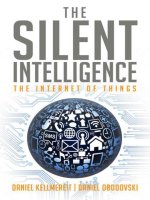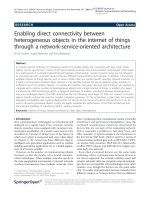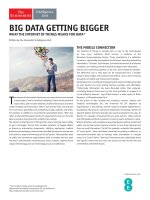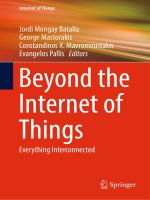The Silent Intelligence: The Internet of Things
Bạn đang xem bản rút gọn của tài liệu. Xem và tải ngay bản đầy đủ của tài liệu tại đây (907.88 KB, 262 trang )
Table of Contents
Copyright
Contents
Foreword
Introduction
Chapter 1: History and Trends
Chapter 2: Technology Ecosystem
Chapter 3: The Future of the Silent Intelligence
Chapter 4: Core Application Domains
Chapter 5: Use Cases
Chapter 6: Getting to Market
Chapter 7: Where to Invest
Conclusion
Acknowledgments© 2013 Daniel Kellmereit and Daniel Obodovski
For information and requests, please contact:
For media contacts:
Web: www.thesilentintelligence.com
Facebook: />LinkedIn: />Internet-Things-5036434
Twitter: @SilentIntelBook
YouTube: />ISBNs:
978-0-9899737-0-0 (Soft Cover)
978-0-9899737-1-7 (eBooks)
CONTENTS
Foreword
Introduction
Chapter 1. History and Trends
Chapter 2. Technology Ecosystem
Chapter 3. The Future of the Silent Intelligence
Chapter 4. Core Application Domains
Chapter 5. Use Cases
Chapter 6. Getting to Market
Chapter 7. Where to Invest
Conclusion
Acknowledgments
FOREWORD
When Daniel Obodovski asked me to write the
foreword to The Silent Intelligence, my first
thought was, “You mean the part of the book that
most people skip over? I can do that.” My second
thought, once I realized he was serious, was, “Um,
sure.” So here we are.
I was lucky enough to start participating in the
Internet of Things movement in 1999, although at
the time we were not at all sure how to even refer
to the potential market. While I had always
expected adoption to happen sooner, I am still very
optimistic that everything will be connected. It’s
just a matter of time. In the early 2000s, we thought
the benefits for companies to connect their
products were so obvious that there would be a
revolution and that it would be over in a few years.
Why would any company delay in making a
relatively small investment in a technology that
enhances their brand, lowers their costs, provides
better customer service, differentiates their product
offerings, builds recurring relationships with
customers, provides higher customer satisfaction
and more? In fact you could even turn on your
coffee machine at work remotely! It was so
obvious to us that we thought people would just do
it, and within three to five years the whole world
would be connected. In fact, sometimes we
worried we might be too late to the dance.
In retrospect, like most adoptions of a disruptive
technology, it didn’t happen in two years. Or even
five. Adoption of M2M has been distributed across
many markets, and fourteen or fifteen years later, it
feels like it has snuck up on us.
Why has it taken so long for the world to catch
on to what some of us have known for over a
decade? It is because in the majority of cases, new
technologies that can disrupt business models take
much more time to be accepted than anyone in that
market wants or expects. In the U.S. market, it took
cell phones about twenty years to get to major
mass-market penetration. Cloud computing (think
Software as a Service, timesharing) can trace its
origins back many, many years. With a handful of
exceptions, tablets being possibly the best-known
outlier, technology adoption takes years.
I think we were fooled, like many early market
entrants, into thinking we would move right from
the visionary customers and early adopters directly
into mainstream adoption. The reality, well
explained in Geoffrey Moore’s book Crossing the
Chasm, is that in order to get across that chasm
between the early adopters and the early majority,
you need to package that technology into something
that is easy for companies to consume. This means
not only offering a complete solution, but offering
it from brands that are trusted and companies that
provide global scale.
One method I use to get a sense of where we are
in market maturity is what is happening to the early
entrants in an ecosystem. Are they burning through
venture capital, announcing the same customers
over and over, going out of business, merging with
other small players, or getting acquired by big
players interested in the space? A significant
indicator for M2M was that once the wireless
carriers got involved in mergers and acquisitions,
that the tipping point into mass adoption was
occurring.
This is exactly what I experienced. First
Qualcomm acquired my M2M platform company,
nPhase, in 2006. This was a huge validation for the
market space and a call for others to start looking
more seriously at the sector. Then, a couple of
years later, we spun it out as a joint venture
between Qualcomm and Verizon Wireless and
eventually sold it to Verizon Wireless.
What is the significance of wireless carriers
entering a space by M&A? From my perspective, it
is that their channels touch almost every company
in the world. When they focus on an initiative, they
have the ability to raise the water level and
dramatically increase the market size. And that is
exactly what they are doing.
The funny thing is that when the mass adoption
does come, it seems like no big deal. Over time we
become acclimated to new technology. In fact, it is
almost when the technology doesn’t seem so gee-
whiz anymore that mass-market adoption has
occurred. It becomes an invisible, silent, part of
our everyday experience.
Well, that feels to me like where we are with
M2M and the Internet of Things. I am not sure if
you can even buy a car today that does not come
standard with connectivity, or at least have it
available as an option. You expect that your e-
reader or tablet is going to seamlessly connect to
the cloud somewhere and download your book or
newspaper. You expect that you can track the
progress of your FedEx package or even the pizza
delivery driver. You expect your printer to tell you
that you are out of ink, you expect to track plane
flights online, and that when you have a problem
with your (computer, air compressor, construction
equipment, MRI machine, truck, whatever) that
someone can remotely connect in and at least
diagnose a problem, if not actually fix it. That is
the promise of a connected world. And it is here,
albeit quite a bit later than I thought it would be.
This is why I think this is a perfect time for
publication of The Silent Intelligence. The Internet
of Everything is still not that well understood in the
general business community, and this book brings
organization to a complex market. It includes
interviews with many of those who have taken an
active part in developing the market. It provides
multiple, valuable perspectives of the Internet of
Things. You will learn about some of the obvious
and not-so-obvious impacts this technology is
having on our everyday lives and how you can
apply these concepts going forward. You will read
about some of the ways companies are leveraging
these capabilities to enhance their businesses. And
on the way, you will enjoy an entertaining,
informing, and informed read by two authors whom
I greatly respect.
Steve Pazol
April, 2013
INTRODUCTION
On a cold day in November 2011, the two of us
were sitting in the conference room of Detecon
USA, on the top floor of a high-rise overlooking
the stunning San Francisco Bay, discussing
technology trends. We used to discuss things like
cloud services, big data, mobile health care, and
so on. We had these discussions every couple of
months, and it seemed like the view of the San
Francisco Bay encouraged big thoughts and
interesting ideas. We often talked about the Internet
of Things, or Machine-to-Machine (M2M)
connectivity, which is a more technical term for it.
The topic appeared confusing on one hand and
exciting on the other, because it was incorporating
many other technology trends.
It’s hard to know which one of us first came up
with the idea to write a book about M2M, but we
both loved the idea immediately and decided to
embark on this project. Indeed, Benjamin Disraeli
once said, “The best way to become acquainted
with a subject is to write a book about it.” Little
did we know what we were getting ourselves into
…
Like a lot of people in the industry, we were
intrigued by the emerging growth of Machine-to-
Machine communication. Our respective skill sets
and backgrounds are complementary — Daniel
Kellmereit is the CEO of a top consulting
company; he’s written several books and has a
well-structured, analytical mind. Daniel
Obodovski has led multiple M2M projects at
Qualcomm and has practitioner’s experience. Both
of us have an extensive network of contacts in the
technology/information systems industry, and
specifically in the M2M space.
We decided to reach out to our respective
networks and interview those with the most
experience to hear and convey their stories. In the
process, we also met and interviewed other
amazing people in the space: pioneers, thinkers,
and visionaries.
One of the things we discovered was how much
of the Internet of Things was actually already
happening around us, without us really noticing,
because the subject is very diverse and not
covered by the popular media nearly as much as,
for example, social networks or smartphones. That
gave us the idea to call our book The Silent
Intelligence, because we feel like machines and
things around us are becoming more intelligent and
are doing so silently.
Although the demands of our respective jobs,
combined with the inherent complications of co-
writing a book, were challenging, we both felt it
was necessary to write The Silent Intelligence —
for ourselves and for you, our readers. With
determination and commitment, we overcame the
challenges this collaborative project presented, to
deliver, over a year later, the finished book you
hold in your hands.
The main subject of this book is how connecting
the physical world around us to the virtual world
of the Internet can result in huge gains. By the
physical world we mean things like cars,
buildings, industrial machinery, home appliances,
medical devices, bicycles, plants, animals, and
human bodies. By gains we mean, for example,
recovering lost or stolen items using embedded
GPS tracking devices, remotely monitoring a
patient’s health using tiny body sensors and thus
preventing a heart attack, or monitoring the
temperature and security of your home — from
anywhere in the world.
The potential is enormous, but so are the
challenges. As Kelly Venturini of M2M Certified
put it, “Everybody wants to get connected and they
don’t freaking know how to do it.”
Much has been written about the Internet of
Things in publications such as the Economist,
Financial Times, the New York Times , McKinsey
Quarterly, and Harvard Business Review, as well
as multiple research studies and white papers by
Harbor Research, ABI, and Frost & Sullivan, to
name a few. We wanted to build upon these
sources, but also go further and deeper in our
examination, to answer these fundamental
questions: What is the Internet of Things? How is it
coming about? What are the key trends? What is
the potential? What needs to be done to succeed in
this space?
Our goal was to first make sense of this vast
topic for ourselves, by analyzing the mentioned
sources, considering our own experience, and
talking to the industry thought-leaders and subject-
matter experts. Then we wanted to share what we
were discovering with our readers. Our hope is
that this book will help you better understand this
space, realize the potential, and recognize the
challenges and complexity. Finally, we want to
share our views on how to overcome obstacles and
identify the most promising areas for investment
and job creation.
The first four chapters of the book take a thirty-
thousand-foot-high view of the subject, while the
last three chapters go into more practical detail
and examine the specific challenges, opportunities,
and examples.
In chapter 1, we start by defining the subject and
what impact it might have on our everyday lives.
Here we also talk about the nature of the terms
Machine-to-Machine and the Internet of Things
and others, such as embedded computing and
smart services. Then we examine the history of the
topic. We followed the advice of Peggy Smedley
of Connected World, who suggested we look back
before we look forward. It was important for us to
understand where the Internet of Things came from,
which trends preceded it, and, more importantly,
which trends are aligning now to facilitate the
exponential growth of new services, businesses,
and opportunities in this space.
Chapter 2 talks about the technology ecosystem
of M2M and its various players. In this chapter, we
attempted to logically split the ecosystem into three
main areas: data collection, data transport, and
data analysis. Here we also talk about the main
technical challenges of the space and the
opportunities that present themselves in addressing
these challenges.
Chapter 3 looks into the future of M2M and the
Internet of Things and focuses on what this brave
new world may look like. We ask some
provocative questions: What role will humans play
when a lot of decision-making is done by
machines, and might humans ever become a
bottleneck to realizing the Internet of Things
vision? We also take a peek at what the ubiquitous
connectivity between various devices may look
like in real terms.
Chapter 4 is dedicated to the core industries of
M2M. We picked connected cities, connected
homes, connected health care, and connected cars.
While these areas do not cover all the aspects of
M2M (not even close), they do offer great
examples of the impact Machine-to-Machine
technology will have. We also hope this overview
will help readers discover new areas for M2M
and the Internet of Things on their own.
Chapter 5 starts by discussing the importance of
well-defined use cases for the success of a
technology or a business. We examine specific use
cases in the M2M space that have been
implemented with varying degrees of success.
Comparing these provides a better map for what
has been working and not working in M2M. We
spend some extra time discussing the use case for
body-worn fitness devices, using BodyMedia as an
example.
Chapter 6 explores the topic of getting an M2M
product to market and the surrounding challenges.
Most of this chapter is based on specific firsthand
experiences in launching M2M products and the
lessons learned. The central part of this chapter is
Mark Wells’ story about how he built his company,
Procon, from zero to one of the largest and the
most successful companies in M2M.
Finally, in chapter 7 we analyze the investment
attractiveness and opportunities of the M2M space,
based on expert views and our own conclusions.
This chapter answers the question: Where would
and should you invest in M2M if you were an
entrepreneur, individual, institutional investor, or a
corporation willing to get involved in the M2M
space?
In the process of writing this book, we
interviewed many industry experts and thought
leaders: Steve Pazol of nPhase and Qualcomm,
Bill Davidson of Qualcomm, Glenn Lurie of
AT&T, Glen Allmendinger of Harbor Research,
Mark Wells of Procon, Steve Hudson of Omnilink,
Kevin Ashton of Belkin, Dr. Sanjay Sarma of MIT,
Assaf Biderman of MIT’s SENSEable City Lab,
Astro Teller of BodyMedia and Google, Bill
Toone of ECOLIFE Foundation, Christian Busch of
SAP, Ioannis Fikouras of Ericsson, Ivo Stivoric of
BodyMedia, John Elliott of Accenture, John Major
of MTSG, Peggy Smedley of Connected World,
Ari Silkey of Best Buy and Zubie, Dermot O’Shea
of Taoglas, Dr. Peter Kuhn of Scripps Research
Institute, and Panos Nasiopoulos of the University
of British Columbia. They tell fascinating stories
about their experiences in the M2M space, which
we did our best to capture and present in our book.
We hope the stories and conclusions in this book
will help you better understand the space and its
potential. And who knows? Perhaps you’ll decide
to start a new business, invest in the M2M vertical
or industry, launch a new project, or just be as
excited about this new growing world as we are.
In any case, we wish you happy reading.
Daniel Kellmereit and Daniel Obodovski
San Francisco, June 2013
Chapter 1
HISTORY AND TRENDS
The future is already here — it’s just not evenly
distributed.
~ William Gibson
How can you tell if something will become so
huge and powerful that it’s going to change our
lives and the way we do business? Below is a
well-known story, popularized by Ray Kurzweil
and retold as we know it, that illustrates the power
of exponential growth.
In ancient China a man came to the emperor
and demonstrated to him his invention of the
game of chess. The emperor was so
impressed by the brilliance of the man’s
invention that he told the man to name his
reward. The man asked for his reward in an
amount of rice — that one grain be placed on
the first square of the chessboard, two on the
second, four on the third, and so on —
doubling the number of grains on each
subsequent square.
Not being a very good mathematician, the
emperor at first thought the reward to be too
modest and directed his servants to fulfill the
man’s request. By the time the rice grains
filled the first half of the chessboard, the man
had more than four billion rice grains — or
about the harvest of one rice field. At that
point the man was rich. By the time the
servants got to the sixty-fourth square, the man
had more than eighteen quintillion rice grains
(18 x 10
18
), or more than all the wealth in the
land. But his wealth and ability to outsmart
the emperor came with a price — he ended up
being decapitated.
In their recent book, Race Against the
Machine,
1
Erik Brynjolfsson and Andrew
McAfee, referenced the fable of the chess and rice
grains to make the point that “exponential increases
initially look a lot like linear, but they are not. As
time goes by — as we move into the second half of
the chessboard — exponential growth confounds
our intuition and expectations.”
As a result, in the early stages of a project or a
new technology, it’s very hard to discern whether
or not something will experience exponential
growth. As you will find in these next chapters, we
believe this is exactly what is going to happen with
the rise of the Internet of Things. If that’s the case,
the next decade and beyond is not only going to be
more amazing from the standpoint of new devices
and services coming to our everyday lives, but we
will also see a dramatic change in our lives and
the way we do business.
Many terms have been coined for the discussion
of this topic: the Internet of Things, Machine-to-
Machine communication or M2M, ubiquitous
computing, embedded computing, pervasive
computing, smart services, and, recently, General
Electric added the term the Industrial Internet to
the mix. One sign that we’re dealing with
something significant is that we are having
difficulty naming it. According to Peggy Smedley,
president of Specialty Publishing Co., editor-in-
chief of Connected World magazine, and host of
the “Peggy Smedley Show” podcast, “Every time
we want to call it something new, people get
confused and they wonder what the Internet of
Things or M2M or embedded computing or the
cloud actually mean. No single term fully
describes the phenomenon. Everyone is seeing a
part of the phenomenon that is closer to him or her
and names it accordingly.”
What is the phenomenon that we are struggling
to name? Let’s look at some examples.
Remote monitoring of industrial machinery
through sensors helps avoid downtime. As Nokia
mentions in their white paper, Machine-to-
Machine: Let Your Machines Talk, “An ice-cream
vending machine wants to tell the supplier that it’s
running out of chocolate cones, enabling the
vending operator to better schedule his on-site
visits.”
2
Plants communicate if they need more
water or food. Wearable electronics help people









